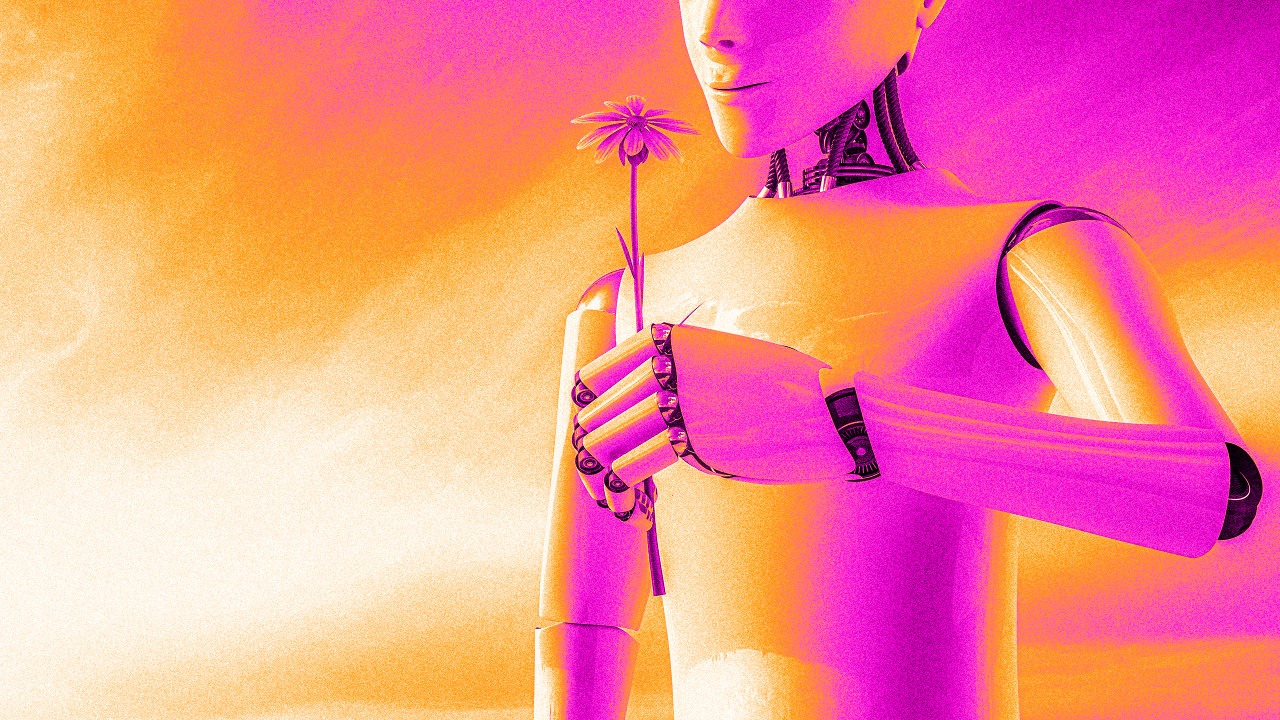Can AI show compassion? Teaching AI to care may teach us to be more human ourselves
In 1859, Charles Darwin unveiled a theory of Evolution that shook the scientific world: the survival of the fittest, where nature thrives on ruthless competition and efficiency. This dog-eat-dog approach profoundly influenced how millions perceive progress for over a century—we celebrated competition (at the expense of compassion) as the engine of evolution. Fast-forward, now, to the 21st century. We’re at an exciting and brave time where technology is bending the very arc of what it means to be human in ways that Darwin could have never imagined. In this new frontier, evidence suggests that fierce competition among human beings is no longer the sole catalyst for advancement. In a somewhat surprising turn of events, compassion is becoming an increasingly crucial variable in the complicated algorithm of human progress. The defining challenge of our generation isn’t just about who can outcompete the other. Rather, it’s about weaving deeper human values—kindness, empathy, and compassion—into the technologies that will shape the future. In doing so, we not only evolve, but we do so in a way that is much more elevated and meaningful than ever before. By putting the collective us above the individual me, we forge a path toward living a more connected, purposeful, and sustainable existence. A false dichotomy: “us vs. them” in human-AI relations As if we’re bracing for an alien invasion, the whispers of “AI taking over” are echoing increasingly louder in our boardrooms, industry conferences, and business meetings. This apocalyptic view of AI, where the “singularity” threatens our own existence, is rooted in an old-world way of thinking fueled by fear and scarcity. Instead of clinging to a “human vs. machine” narrative, what if we viewed AI as an evolutionary way to amplify our potential rather than to compete with it? AI is a conversation in progress, not regress. It has the potential to help solve world problems that continue to plague us—hunger, climate change, sickness, challenging access to appropriate medical treatment, and so many others. Picture a rural village in India, where medical doctors, particularly specialists, are few and far between. Here, a well-trained and fully compliant AI-powered diagnostic tool could bridge a deep availability and expertise gap (not by replacing human doctors, but by extending their reach.) This much-needed innovation could offer life-saving expertise where none existed before. Another great example is the rise of AI-powered therapy companions. During long, lonely days or late-night anxiety attacks that too many in this country and worldwide experience every day, an AI therapist can be a readily available and timely resource, accessible when isolation threatens someone’s mental health and well-being. This kind of friendly AI companion wouldn’t be around to replace the human touch but rather to be present, available, and valuable when human touch is not there to be had. This isn’t a futuristic concept; AI companions are already here, shaping our world today as we speak. And they are doing it for the better, rather than threatening our very existence or finding a way to put us all out of business. AI’s role isn’t to compete with us—it’s to collaborate and help us help people and places where human effort alone is not as available or readily accessible. Digital empathy A few short years ago, the idea of AI engaging in meaningful conversations seemed far-fetched. But today, AI can hold conversations that are sometimes indistinguishable from those with humans (in the game Human or Not, half the time people can’t even tell if they’re talking to a bot). AI systems can now generate responses that resonate with us, raising questions about their authentic understanding of our emotions. Perhaps, AI is learning from us and becoming a better version of itself (or paradoxically, could it even evolve into a better version of us?!). Consider the AI-powered chatbots used in customer service, designed not just to answer questions, but to recognize and respond to emotional cues from customers. The AI system might detect frustration in a customer’s tone and digital demeanor and adjust its responses to offer more empathy and support, simulating an understanding of the customer’s emotional state and ultimately providing much better service. This should sound much better than arguing with a disgruntled/overworked/often yelled-at employee over a product or service that didn’t meet your expectations. Another compelling example is AI in mental health applications. Tools like Woebot offer emotional support through conversations that use cognitive-behavioral therapy techniques. Users report finding solace in these interactions, even though they come from a virtual entity. In the end, human or bot, what really matters is how the original human on the other end of the conversation feels at the end of it. Nonetheless, this phenomenon raises the quest

In 1859, Charles Darwin unveiled a theory of Evolution that shook the scientific world: the survival of the fittest, where nature thrives on ruthless competition and efficiency. This dog-eat-dog approach profoundly influenced how millions perceive progress for over a century—we celebrated competition (at the expense of compassion) as the engine of evolution.
Fast-forward, now, to the 21st century. We’re at an exciting and brave time where technology is bending the very arc of what it means to be human in ways that Darwin could have never imagined. In this new frontier, evidence suggests that fierce competition among human beings is no longer the sole catalyst for advancement. In a somewhat surprising turn of events, compassion is becoming an increasingly crucial variable in the complicated algorithm of human progress.
The defining challenge of our generation isn’t just about who can outcompete the other. Rather, it’s about weaving deeper human values—kindness, empathy, and compassion—into the technologies that will shape the future. In doing so, we not only evolve, but we do so in a way that is much more elevated and meaningful than ever before. By putting the collective us above the individual me, we forge a path toward living a more connected, purposeful, and sustainable existence.
A false dichotomy: “us vs. them” in human-AI relations
As if we’re bracing for an alien invasion, the whispers of “AI taking over” are echoing increasingly louder in our boardrooms, industry conferences, and business meetings. This apocalyptic view of AI, where the “singularity” threatens our own existence, is rooted in an old-world way of thinking fueled by fear and scarcity.
Instead of clinging to a “human vs. machine” narrative, what if we viewed AI as an evolutionary way to amplify our potential rather than to compete with it? AI is a conversation in progress, not regress. It has the potential to help solve world problems that continue to plague us—hunger, climate change, sickness, challenging access to appropriate medical treatment, and so many others.
Picture a rural village in India, where medical doctors, particularly specialists, are few and far between. Here, a well-trained and fully compliant AI-powered diagnostic tool could bridge a deep availability and expertise gap (not by replacing human doctors, but by extending their reach.) This much-needed innovation could offer life-saving expertise where none existed before.
Another great example is the rise of AI-powered therapy companions. During long, lonely days or late-night anxiety attacks that too many in this country and worldwide experience every day, an AI therapist can be a readily available and timely resource, accessible when isolation threatens someone’s mental health and well-being. This kind of friendly AI companion wouldn’t be around to replace the human touch but rather to be present, available, and valuable when human touch is not there to be had.
This isn’t a futuristic concept; AI companions are already here, shaping our world today as we speak. And they are doing it for the better, rather than threatening our very existence or finding a way to put us all out of business. AI’s role isn’t to compete with us—it’s to collaborate and help us help people and places where human effort alone is not as available or readily accessible.
Digital empathy
A few short years ago, the idea of AI engaging in meaningful conversations seemed far-fetched. But today, AI can hold conversations that are sometimes indistinguishable from those with humans (in the game Human or Not, half the time people can’t even tell if they’re talking to a bot).
AI systems can now generate responses that resonate with us, raising questions about their authentic understanding of our emotions. Perhaps, AI is learning from us and becoming a better version of itself (or paradoxically, could it even evolve into a better version of us?!).
Consider the AI-powered chatbots used in customer service, designed not just to answer questions, but to recognize and respond to emotional cues from customers. The AI system might detect frustration in a customer’s tone and digital demeanor and adjust its responses to offer more empathy and support, simulating an understanding of the customer’s emotional state and ultimately providing much better service. This should sound much better than arguing with a disgruntled/overworked/often yelled-at employee over a product or service that didn’t meet your expectations.
Another compelling example is AI in mental health applications. Tools like Woebot offer emotional support through conversations that use cognitive-behavioral therapy techniques. Users report finding solace in these interactions, even though they come from a virtual entity. In the end, human or bot, what really matters is how the original human on the other end of the conversation feels at the end of it. Nonetheless, this phenomenon raises the question of whether AI truly understands users’ emotions, or simply uses algorithms to simulate empathy based on a cold computation.
The answer is likely that we’re still in the simulation phase of fully “humanized” AI. Even so, deep understanding and authentic empathy are likely closer than we may think. Machines don’t feel the way we do, but they’re getting better and better at replicating human interaction by learning from and regularly interacting with humans.
What we’re witnessing isn’t empathy as humans know it; it’s digital empathy—a simulation so refined that it invokes real emotional value in those on the receiving end. Is this a distinction without a difference or a difference with a huge distinction?
Beyond utility
The true dilemma of this brave new frontier isn’t whether AI can feel—it’s whether AI can act compassionately and based on its “emotions.” Hollywood has conditioned us to expect sentient machines grappling with humanlike consciousness.
But the real leap forward won’t be found in machines feeling emotions. Instead, it lies in programming them to understand emotions and act compassionately and ethically based on a certain set of facts and a distinct exchange between them and people and between other people.
Compassion is a high-level cognitive process, more a form of reasoning than a mere reaction. By teaching AI to understand context, nuance, feelings, and ethical considerations, we’re embedding the best parts of humanity into systems that will never know what it’s like to cry or laugh. Think of it like teaching a child manners before they fully grasp the meaning behind them—over time, with practice and experience, those practices evolve into genuine empathy.
Even if it would be challenging to program AIs to deeply love or genuinely grieve, we can and should teach them to act compassionately and ethnically, which is likely to make their world and ours a more pleasant one to live in.
The compassion paradox
In our quest to program compassion and teach machines how to care, we encounter a fascinating paradox that forces us to grapple with and clarify what compassion truly means to us. It is a question we rarely consider unless something goes tragically wrong in a meaningful relationship or connection.
Think about it like this: How often do you, as a human being:
- Truly assess how you treat others
- Deeply consider if you are compassionate to those around you
- Carefully study how your behavior impacts the feelings of your closest friends and family members
As engineers, product managers, and designers who code ethical frameworks and empathy algorithms, we are essentially engaged in a reflective process of clarifying our own values. This process not only involves defining how AI should think, feel, and therefore behave but also compels us to reassess our own values and our approach to empathy and compassion.
Teaching AI to care serves as a figurative mirror, reflecting the areas where our own morals and empathy may need refinement. This exercise in translating nuanced human feelings into algorithms pushes us to confront the gaps in our own empathy and moral reasoning. It challenges us to more rigorously apply this understanding in our own lives and work.
As we break down complex human emotions into code, we gain a clearer insight into our own emotional frameworks. This process reveals not only the limitations of AI but also the intricacies of the human soul. AI, in this context, becomes a powerful tool, a catalyst for reflection, contemplation, and self-awareness.
Forging a symbiotic future with compassionate AI
Winston Churchill once said, “We shape our buildings; thereafter they shape us.” The same is true for AI. As we code compassionate systems, those systems will become our virtual reality and eventually our actual reality, which will in turn shape us.
The future isn’t about a showdown between humans and machines. It’s about coevolution—where carbon and silicon, heart and mind, merge to create something greater than the sum of their parts.
Today, compassion is a uniquely human trait, but it doesn’t have to stay that way. By embedding compassion into the very fabric of our technology, we’re not just pushing forward the efficiency frontier; we’re scaling empathy.
This isn’t about programming machines to replace humanity. It’s about partnering with them to enhance it. The next great leap in evolution won’t be powered solely by logic and computation and driven solely by competition. It will be driven by compassion—augmented, scaled, and perfected by our silicon partners.






















